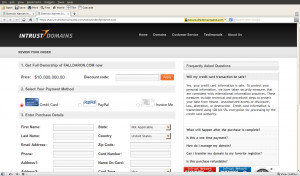I am normally pretty careful about my on-line security and privacy. I take a lot of care to ensure that my home network is nailed down tightly and all the clients and servers on it are also nailed down as well as I know how. I don’t use software which is susceptible to the majority of the malware out there; my browser is nailed down as tightly as I can get it whilst still allowing it to be useful (roll on HTML5, I hate flash, but it is so damned useful); I do some, very specific, browsing (such as on-line banking) from within a VM and do not use that browser or machine for anything except that specific activity; I routinely bin cookies and flash LSOs (in fact I find it better to disallow all LSOs in the first place); this blog does not include any email addresses harvestable by ‘bots; my email client is a niche (i.e. minority) product and is configured only to allow text (no HTML or embedded images or webbugs); I use tor when I want to be as anonymous as possible; my local DNS server blocks access to a whole range of addresses I don’t like; and I never respond to unsolicited email.
But I got phished. Damn.
Here’s what happened.
I advertised an unwanted mobile phone on gumtree. I chose gumtree in preference to ebay because a) adverts are free, and b) gumtree allows you to target the advertising to a specific location. I like this idea because it means you can say “I’ve got a doohickey for sale in South London. Come and see it and pay cash if you want it”. My ad gave details of the item for sale and, as is recommended, I chose to have responses emailed to me. Here I made mistake number one – I used my normal email address rather than a disposable one. To be fair, gumtree don’t expose any of your private details, they just forward any responses to the address you give. Here’s where I made mistake number two, I responded to queries about the ad from the address given to gumtree. Damn. Idiot. So stupid.
So why do I think the responses weren’t kosher? Well there were a number of giveaways. Firstly the requests were for information already in the ad (“how much do you want?”); secondly, there were a suspiciously high number of “spilling misteaks” in the emails; thirdly, the correspondent wanted me to mail the ‘phone to a location outside the UK (“Thanks for your quick respond actually i will love to buy the Ad for my Daughter who is currently studying at British international college (BIC) in West Africa so am willing to pay you additional £48.76 for the shipping via Express Air Mail.” (sic)); fourthly, the respondents all seemed desperately keen for me to accept paypal as the preferred payment option. I’m normally quicker on the uptake than this, but sadly it took me four or five emails to realise that there was a pattern here and that the people after the phone seemed to be following a script and were completely ignoring my responses. Here’s a sample:
Someone calling him or her self “Janet Mason”:
“Hello Seller,
Can I know the condition of the item? I think you will accept PayPal. And I will pay the postage and packing cost for the item. If you can send me paypal payment request now and I will make the payment straight away without any delay. Hope to hear from you very soon.”
My response:
“Janet
As the ad say, the phone is in “as new condition”. This means what it says. The phone is completely clean and has no visible markings or scratches.”
“Janet’s” reply:
“Ok send me your paypal Payment request now so that I can make the payment now.”
My response:
“I’d like a bit more detail first please.
Where are you? (Full address and telephone mumber so that I can confirm that I am sending to “Janet Mason”.
Details of your confirmed paypal account (so that I know that Paypal have verifed you).
If you want to know why I am concerned please read the paypal guidance for sellers – particularly the bit about sending only to UK or US based addresses and getting signatures on receipt of goods.
I have received several requests to send the phone to “my daughter/son/nephew” or whatever in various Countries outside the EU. I am naturally suspicious.”
“Janet” then says:
“Hello,
Am in London right now but due to the nature of my work here in London I will not be able to post the item to my Business Partner Daughter in Nigeria as a New Year Gift. But I will pay for the postage and packing cost via FedEX. Get back to me with your paypal payment request now so that I can make the payment now and get the item posted out tomorrow Morning.”
Correspondence ends…..
Now whilst I have not lost the ‘phone, I have verified a usable email address to a bunch of scammers. I expect my spam volume to that address to increase dramatically. Never mind though, I’m not alone in losing out to the bad guys, and at least I haven’t lost any passwords in the process.
Still, I’m pretty pissed off.



